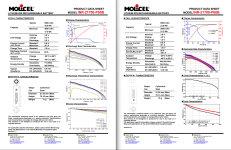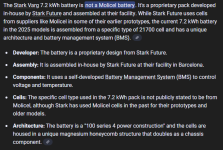This might be suitable for battery enthusiasts like us.
Well, I think many probably already knew this, but I wanted to create a thread dedicated to this Molicel technology, which Stark will likely be working with for a long time.
From what I've been researching, the new P60B cells have been available to the public since the end of August, after the testing period.
They belong to the same category of 21700 power cells; the capacity has increased from 5000mAh to 6000mAh and from 18Wh to 21.6Wh. The voltage is the same under nominal and charging conditions, but the discharge voltage has decreased from 2.5V to 1.8V. The charge current has also increased from 5.0A to 6.0A under standard conditions and from 25A to 30A at maximum.
Now I'll comment on what has disappointed me about this new version. A few months ago I read that the P60B cells had the same weight but more capacity (not true, I'll talk about this later). So, considering that the P50B cells have 260Wh/kg and weigh 70g each, the calculation would be to multiply 70g x 400 cells = 28kg, not counting the magnesium casing. Now you multiply 260Wh/kg x 28kg = 7,280kWh, which is the current capacity of the MX1.2, EX, and SM models. If we do the same calculation with the P60B cells, assuming they have the same weight of 70g but a higher gravimetric capacity of 280Wh/kg, the result would be 280Wh/kg x 28kg = 7,840kWh. But the problem is that the weight of the P60B cells has increased by 5g, so the calculation is no longer based on 28kg but on 30kg if we leave the battery with the same number of 400 cells.
This would give us a capacity of 280Wh/kg x 30kg = 8,400kWh, which would be very good but at the cost of 2kg more weight.
For some, this will be a problem, and for others, not. I don't see it as so relevant for the SM model, but it is for Enduro and motocross.
On other websites, not the official Molicel site (I'll attach a screenshot), they say that the P60B batteries have 288Wh/kg instead of 280Wh/kg. Here, we would have more leeway to achieve 288Wh/kg x 28kg = 8,064kWh by removing some cells instead of all 400. And that would be really good. Or, we could keep the extra 2kg and obtain 8,640kWh with the 400 cells. This configuration would work well with the new ALG model and the other Adventure projects that Stark has, where the weight can be increased without being a problem. They could even have greater capacity and weight; the limit will be set by Stark with his lightweight philosophy. I think Stark failed on not waiting for the P60B for the SM model, maybe they didnt want to wait for some more for so many reasons.
Molicel says their goal is to increase the capacity of their cells by 10% per year; let's hope they can achieve it. I can't wait to have at least 360 Wh/kg and, with the same 28 kg weight, reach 10,080 kWh of capacity. A DREAM!
SCREENSHOTS BELOW:

Web where it says 288wh/kg instead 280wh/kg, i think oficial Molicel info should be more accurate

Well, I think many probably already knew this, but I wanted to create a thread dedicated to this Molicel technology, which Stark will likely be working with for a long time.
From what I've been researching, the new P60B cells have been available to the public since the end of August, after the testing period.
They belong to the same category of 21700 power cells; the capacity has increased from 5000mAh to 6000mAh and from 18Wh to 21.6Wh. The voltage is the same under nominal and charging conditions, but the discharge voltage has decreased from 2.5V to 1.8V. The charge current has also increased from 5.0A to 6.0A under standard conditions and from 25A to 30A at maximum.
Now I'll comment on what has disappointed me about this new version. A few months ago I read that the P60B cells had the same weight but more capacity (not true, I'll talk about this later). So, considering that the P50B cells have 260Wh/kg and weigh 70g each, the calculation would be to multiply 70g x 400 cells = 28kg, not counting the magnesium casing. Now you multiply 260Wh/kg x 28kg = 7,280kWh, which is the current capacity of the MX1.2, EX, and SM models. If we do the same calculation with the P60B cells, assuming they have the same weight of 70g but a higher gravimetric capacity of 280Wh/kg, the result would be 280Wh/kg x 28kg = 7,840kWh. But the problem is that the weight of the P60B cells has increased by 5g, so the calculation is no longer based on 28kg but on 30kg if we leave the battery with the same number of 400 cells.
This would give us a capacity of 280Wh/kg x 30kg = 8,400kWh, which would be very good but at the cost of 2kg more weight.
For some, this will be a problem, and for others, not. I don't see it as so relevant for the SM model, but it is for Enduro and motocross.
On other websites, not the official Molicel site (I'll attach a screenshot), they say that the P60B batteries have 288Wh/kg instead of 280Wh/kg. Here, we would have more leeway to achieve 288Wh/kg x 28kg = 8,064kWh by removing some cells instead of all 400. And that would be really good. Or, we could keep the extra 2kg and obtain 8,640kWh with the 400 cells. This configuration would work well with the new ALG model and the other Adventure projects that Stark has, where the weight can be increased without being a problem. They could even have greater capacity and weight; the limit will be set by Stark with his lightweight philosophy. I think Stark failed on not waiting for the P60B for the SM model, maybe they didnt want to wait for some more for so many reasons.
Molicel says their goal is to increase the capacity of their cells by 10% per year; let's hope they can achieve it. I can't wait to have at least 360 Wh/kg and, with the same 28 kg weight, reach 10,080 kWh of capacity. A DREAM!
SCREENSHOTS BELOW:

Web where it says 288wh/kg instead 280wh/kg, i think oficial Molicel info should be more accurate


